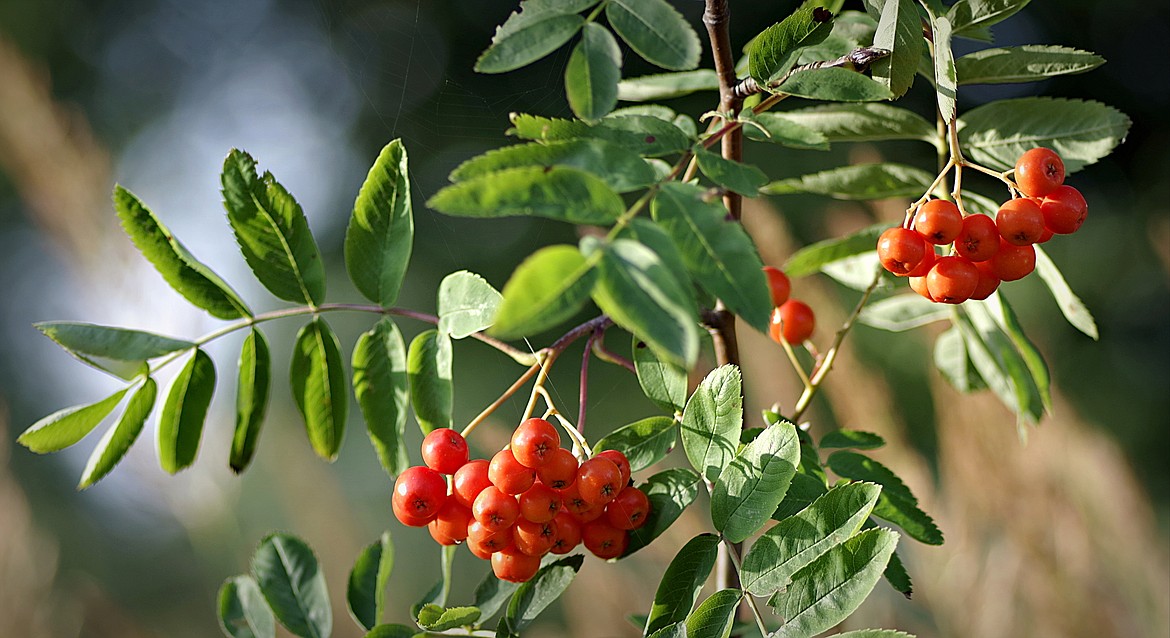Native shrubs are the answer to landscaping needs
If you are planning some spring landscaping, think native! Whether tree, shrub or ground cover, natives guarantee long-lived shelter and often sustenance for bird and wildlife as well as beauty to your surroundings.
Consider fruit-bearers like Mountain ash, Serviceberry, Hawthorn, elderberry, wild raspberry, currant, Oregon grape, Thimbleberry, Sumac and groundcovers like Kinnikinnick, wild strawberry and Dewberry. Don't forget the four native species of roses which not only regale the surroundings with fragrance, but provide leafy, thorny shelter followed by nutritious rosehips for winter food. Too, the catkins of Alder and willows comprise "fruit" beloved by finches
The green leaves and lovely white blossoms of Serviceberry (Amelianchier alnifolia) are the first native shrub to welcome spring. The flowers are followed by long-lasting blue-purple berries beloved of birds.
While technically a shrub, Serviceberry can literally turn into a great tree-like focal-point, so give it plenty of room. In the landscape it can add beauty and drama when planted as a focal point or in front of any evergreen, preferably a big one. In the fall, blue (seedy) berries, which can be quite delicious appear and the leaves turn to red and last longer, often confusing huckleberry pickers out in the boonies who don't always distinguish between the plants.
The Elderberry (Sambucus cerulea) is another possibility. Its dark green pinnate leaves and white flower umbrels turn to a gorgeous flaming display with dusty/dark blue berry clusters. Like Serviceberry, it is a hardy native and can get very large, so let it stand on its own or fronting big trees For beauty and density, augment either the Serviceberry or Elderberry with any of the currants (Ribes): Red-flowering, blood currant, etc. All currants have the beautiful drooping flower clusters in shades of red or pink, sometimes white - looking like mini-fuchsias, joined later by the foliage, and then setting the fruit which can be red or black. Great for jelly.
The wild Rubus family, raspberry and blackberry, are always welcome. The red raspberry and blackcaps are smaller but just as sweet versions of the domesticated varieties, and the great arching branches of the large wild blackberry are priceless treasures wherever found, providing dramatic elegance, delectable fruit and priceless bird shelter.
For berry trees, you can't beat Mountain ash. Sitka Mountain Ash (Sorbus sitchensis) is our native, shrubbier, variety, with large, orange-red berries. It transplants well and is available at some of our area nurseries. It offers lovely green-to-yellow-to-red pinnate leaf fronds and is an asset to any landscape as well as being a bird-magnet..
The native Hawthorn (Crategus) often referred to as "Thornapple" is attractive in its own way, sometimes growing in a gnarly, almost Oriental, manner. Its vicious thorns somewhat negate its popularity, but provide wonderful protection for songbirds, who also appreciate the "haws" or fruits.
Shorter possibilities include Chokeberry (Aronia), which grows as a small tree or shrubby bush depending on site placement. The leaves turn a glorious red and the glossy black (also red) berries make a good jelly. The shrubs present a showy display of delicate white flowers in May.
Sumac, too, is a possible choice. Staghorn sumac, with its "furry" stems and amazing red flower-seed clusters, is a show-stopper, and while it's slow to get started, will become a big, beautiful specimen with winter-red leaves to enhance the bird-attracting clusters.
As to groundcover berries, the earlier mentioned possibilities can enhance your landscape regardless of site and soil, since each is suited to a variety of locations: Kinnikinnick handles dry, sunny sites with aplomb; Alpine strawberry (fragaria) prefers a bit more moisture and richness but as all natives, loves our naturally acidic soil.
Dewberry - (trailing blackberry - Rubus), while sporting nasty, foot-tangling, needled vines, is ideal for slopes or open areas where you don't want anyone intruding. You will welcome the small but delectable black berries in the early autumn, however, just don't get your ankles tangled in the needle-like thorns.
You can track down many of these wonderful gifts of nature for your own landscaping and remember, they are only the tip of the iceberg: Native plants, once established, want nor need no special care: no fertilizers ever! no pesticides - ever! They give freely of their beauty, their bounty and their hardiness. All you have to do is harvest what you want and leave the rest for the birds!
Visit our area nurseries for more ideas of fruiting or ornamental trees to enhance your property. Too, take a stroll at the Native Plant Society Arboretum next to the Bonner County Museum. I am proud to be one of the original ground-breakers/creators at its “birth.”
Valle Novak writes the Country Chef and Weekend Gardener columns for the Daily Bee. She can be reached at bcdailybee@bonnercountydailybee.com or by phone at 208-265-4688 for questions between the hours of 8 a.m. to 6:30 p.m. a 208-265-4688.





